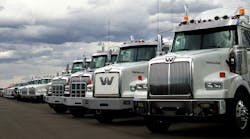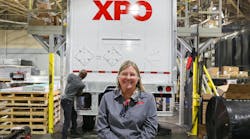MANAGER: Bob DeKruyff
TITLE: Director of design and development controls
FLEET: U-Haul International Inc., Phoenix, AZ
OPERATION: National truck rental fleet comprised of over 101,000 trucks and 76,000 trailers
PROBLEM:
Not only do tires represent one of the largest maintenance issues for fleets, they also can have a significant effect on vehicle performance. And sometimes, existing procedures regarding tire positioning designed to maximize lifecycle value doesn't always fit with what's best in terms of vehicle safety.
That's particularly true in the truck rental fleet world, says Bob DeKruyff, director of design and development controls for U-Haul International's technology center in Tempe, AZ.
“The issue is simply this: The rental truck driver is very different from the professional freight operator you see behind the wheel of over-the-road tractors,” he explains. “We're usually dealing with a driver who drives a large truck maybe once or twice in their lifetime, so they are typically unfamiliar with its handling characteristics.”
How does that relate to tire positioning? “For decades, we've put new tires, the ones with the deepest tread, on the front axles,” DeKruyff points out. “That's great from a life expectancy perspective, but not necessarily the best from a traction perspective, especially on our lighter four-axle, 8,500-lb. -GVW trucks. Better traction on the rear axles can result in far better handling and traction for the less experienced driver.”
SOLUTION:
DeKruyff's research indicates that vehicle braking, cornering and traction are directly affected by tire condition, yet a broad canvassing of the truck fleet community found no discernible difference in requirements for four- or six-wheeled trucks (regardless of whether six-wheeled trucks sport a single “dualie” rear axle or a tandem axle). Yet traction is significantly affected by whether a vehicle has four or six wheels, DeKruyff found. The concern over traction centers around two types of vehicle situations: understeer and oversteer. DeKruyff says most drivers can overcome or adjust to an understeer situation. Oversteer, however, is a condition where a vehicle will tend to turn more than expected in the desired path. Most drivers are not trained to correct for this condition and in extreme cases can overcorrect and lose control of the vehicle.
“The important point here is that these trucks are rented to individuals with diverse demographic backgrounds, not only from an experience level, but also from physical-operating environments,” DeKruyff stresses. “Above all, it is critical to consider driver safety as the most important factor in tire maintenance and replacement policies.”
There's another consideration too: how best to mitigate the impact of tire blowouts, usually referred to as “rapid air loss,” or RAL, events in trucking jargon. “It is much more important to mitigate an RAL situation on the rear of a four-wheeled vehicle than it is to mitigate it on the rear of a six-wheeled vehicle from the perspective of maintaining vehicle control, reinforcing the need to maintain the best tires on the rear of a four-wheeled vehicle if at all possible,” DeKruyff says. “Six-wheeled vehicles do experience a similar situation, but to a much lesser degree. Additionally, since modern vehicles are designed with a certain amount of overall understeer, a slight amount of oversteer caused by RAL on the rear of a six-wheeled vehicle will result in minimal disruption of controllability.”
For those reasons, U-Haul is now mounting new tires on the rear axles of some trucks but on the front axles of others. Its four-wheeled light-duty trucks with GVWRs of less than 10,000 lbs. — some 25% of its fleet — have new tires placed on their rear axles. Its six-wheeled medium-duty trucks with GVWRs up to 20,000 lbs. — some 75% of the fleet — get new tires on their front axles.


